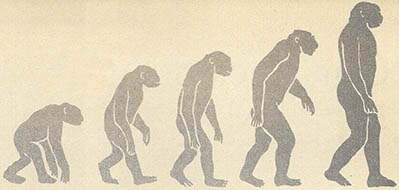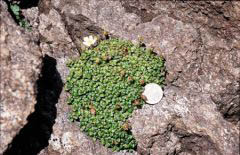인류는 지구상에 새로 온 손님이다. 우리는 지구의 아주 오랜 수명과 비교해서 볼 때 이곳에 오래 동안 존재하지는 않았으나, 우리가 생각하는 것보다는 더 오래 머물러 왔다. 그리고 우리가 혹은 우리 조상들이 더욱 더 오래된 존재임을 보여 주는 새로운 측정들을 함으로써 과학자들은 그들 스스로 아직까지도 종종 놀라고 있다.
근래에 이르기까지 서구 학자들은, 심지어 과학자들까지도 성경이 암시하고 있다고 여겨 지기 때문에, 인류가(그리고 지구 자체도) 단지 6천여년 정도밖에 안되었다는 것을 당연하다고 생각했다. 그러나 일찌기 1797년 영국인 '존 프레르'는 원시인들이 만들었음에 틀림 없는 조잡하게 다듬어진 석기들을 발견했다. 그러한 도구들은 지하 13피트에서 발견되었다. 손상 되지 않고 남아 있는 물건들은 서서히 먼지와 진흙으로 덮여서 암석으로 바뀌고, 깊게 묻힌 어떤 도구들은 6천년 보다도 더 오래되었음이 틀림없다.
그 후 '에드와르 라르떼'라는 한 프랑스인은 맘모스의 그림이 훌륭하게 새겨져 있는 고대 맘모스의 이빨을 찾아냈다.
이것은 분명히 오래전에 사멸한 맘모스와 같은 시기에 살았던 인간에 의해서만이 그려질 수 있을 것이다.
차차 유골은 인간의 유기 조직과는 상당히 다른 것으로 판명이 되었으나, 골격 구조에 있어서는 원숭이들의 것보다는 인간의 것에 가까왔다.
이들은 '원인(原人)'이라고 불리워 졌고, 그들은 현대 인간의 조상인 호모사피엔스(혹은 방계 친척)이던 생명체의 긴 혈통을 나타내 주었다.
원인들이 오래되었다고는 알려졌지만, 그러나 얼마나 오래되었을까?
과학자들은 유골들이 발견된 땅속 깊이와 그것들을 둘러 싸고있던 다른 동물들의 뼈의 종류를 파악함으로써 대각 추측만 할 수 있었다. 원인들이 지구상에 수십만년동안 존재해 왔을 것이 아닌가하고 추측되었으나, 그 연대는 확실하지 않았다.
그렇지만 1896년에 방사능이 발견되었다. 어떤 종류의 원자들은 불안정하고 측정가능한 일정한 비율로 붕괴한다는 것이 알려 졌다. 즉 우라늄은 45억년이 지나면, 그 절반이 납으로 바뀌는 비율로 붕괴하였다. 1907년에 미국인 '버트램 B. 볼트우드'는 우라늄을 포함하고 있어야 할 것이라고 주장했다. 우라늄과 납의 비율로부터, 여러분은 우라늄이 얼마만큼 붕괴되었으며 그 암석이 얼마나 오래되었는가를 계산할 수 있다.
이것이 파손당하지 않은 암석들의 나이를 깔끔하게 측정하는데 사용될 수 있는 '방사능 연대측정'의 시작이었다. 어떤 암석들은 방사능 연대측정에 의해, 약 35억년동안 상하지 않고 존재해 왔다는 것이 밝혀 졌다. 따라서 지구는 그 보다 더 오래 됐을 것이 틀림없다.
처음부터 손상되지 않고 남아 있는 운석들은 나이가 약45억년되었다고 보여지는데, 이것은 현재 지구와 태양계의 나이로 여겨지고 있다.
만약 여러분이 암석속에 파묻혀 있는 원인의 뼈를 발견한다면, 자연적으로 여러분은 암석의 나이를 결정하고 또한 그 뼈의 나이를 결정할 것이다. 그러나 모든 암석이 그 속에 나이를 결정할 만큼 충분한 우라늄을 가지고 있지는 않지만 모든 암석속에는 공통 원소로서 칼륨을 어느 정도 갖고 있다. 어떤 칼륨 원자들은 방사능이 있고 13억년 동안에 그 절반이 사라지는 비율로 불활성 기체인 아르곤으로 붕괴한다. 암석속에 있는 칼륨과 아르곤 거품들을 측정함으로써 암석이 형성되고 뼈들이 그 속에 들어간 이래로부터의 시간의 길이가 결정될 수 있다.
차차 시간이 지남에 따라 이러한 연대 측정기술은 자연히 개선되었고 원인들이 이전에 생각한 것 보다는 더 오래 됐다는 사실이 밝혀졌다. 지난 9월에 유타대학 출신의 과학자들은 케냐에 있는 고대의 도구들이 포함된 암석들의 연대를 측정했다. 그 암석들은 50만년 정도 되었다고 생각되었으나, 새로운 측정들은 적어도 70만년, 또는 아마 90만년 정도 되었다고 지적한다.
그리고 물론 그보다 오래된 원인들이 있다. (그들은 아프리카의 동부나 남부에서 진화한 것으로 보인다. 이 사실은 원인이 아닌 우리 친척들 중에서 가장 가까운 침팬지나 고릴라가 그 곳에 살고 있기 때문에 놀랍지 않다.) 동아프리카에 있는 '올듀바이 조지'란 곳의 암석속에서 발견된 원인 두개골과 원시적 도구들이 약 1백80만년이나 되었음이 증명됨으로써 과학자들을 놀라게 했다. 그 원인들은 우리 인류의 일부였으며 '호모 하빌리스'로 불리웠다.
'호모 하빌리스' 이전에 훨씬 더 원시적인 원인들이 존재했으나 그들은 우리들과 너무나 달라서 인간으로 간주될 수 없다. 그러나 그들 역시 원인이었다. 예를 들면 그들도 우리와 같은 엉덩이와 다리를 갖고 있었고 우리만큼이나 쉽게 직립 보행을 할 수 있었다. 이렇게 가장 오래된 사람을 '오스트랄로피테쿠스 아파렌시스'로 부른다. 약 4백만년 전의 지층에서 화석화된 뼈들이 발견되었다.
의심할 여지 없이 더 오래된 예가 있을 것이다. 지구상에 5백만년 동안 원인들이 존재해 왔다고 가정하는 것이 합리적으로 보인다. 이것은 인류와 그의 원인 선조들을 2세기전에 학자들이 생각했던 것보다 약 8백배나 오래된 것으로 만들었다. 그러나 (비례의 감각을 꼭 유지한다면) 원인들은 여전히 지구존재의 마지막 1천분의 일 동안에 존재해 왔을 뿐이다.

The human species is a newcomer on Earth. We haven't been here for long compared with Earth's mighty lifetime, but we have been around longer than we used to think. And scientists are still periodically surprising themselves with new measurements that show us, or out forebears, to be more and more ancient.
Until modern times, Western scholars, even scientist, took it for granted that humanity (and Earth itself) was only 6,000 years old or so, because that was what the Bible seemed to imply. As early as 1797, however, an Englishman, John Frere, discovered crudely fashioned flint tools that must have been made by primitive human beings. Those tools were discovered 13 feet underground. Objects that remain undisturbed are slowly covered by dust and mud that turns into rocks, and tools buried that deep must be far more than 6,000 years old.
Later, a Frenchman named Edouard Lartet found an ancient mammoth tooth on which was scratched an excellent drawing of a mammoth. It could only have been drawn by a human being who lived at the same time as the long-extinct mammoths did.
In time, bony remains were found of organisms that were not quite human beings, but were closer to human beings in skeletal structure than they were to apes. These were called "hominides," and they represented a long line of organisms that were ancestors(or collarteral branches) of modern human beings - Homo sapiens.
Hominids were known to be ancient, but how ancient?
Scientists could only guess rather roughly by estimations from the depths at which the remains were found, and the kind of bones of other animals that surrounded them. It was suspected that hominids might have existed of Earth for hundreds of thousands of years, but the dating was not firm.
In 1896, however, radioactivity was discovered. It was found that certain kinds of atoms were unstable and broke down at a fixed rate that could be measured.
Thus, uranium broke down to lead at a rate at which half the uranium would be turned into lead in 4.5 billion years.
In 1907, an American, Bertram B.
Boltwood, suggested that rocks that contained uranium would also have to contain lead. from the proportions of uranium and lead, you could calculate how much uranium had broken down and therefore how old the rock must be.
This was the beginning of "radioactive dating," which could be used to neatly determine the age of undisturbed rocks. Some rocks have been discovered which, by radioactive dating, prove to have, lain undisturbed for 3.5 billion years, so the Earth must be older than that. Meteorites, which have been undisturbed from the very beginning, show ages of about 4.5 billion years, which is now taken as the age of the Earth - and the solar system.
Naturally, if you discover hominid bones embedded in rock, then you determine the age of the rock, you will also have determined the age of the bones. Not all rocks have enough uranium in them to make a determination, but they all have some of the common element potassium in them.
Certain potassium atoms are radioactive and break down to inert gas argon at such a rate that half the potassium in gone in 1.3 billion years. By measuring the potassium and the trappled argon bubbles in rocks, the length of time since those rocks formed and tose bones were encased can be determined.
Naturally, as time passed, techniques for such dating improved and usually hominids turned out to be older than previously thought. This past September, scientists from the University of Utah dated rocks in Kenya that contained ancient tools. The rocks had been thought to be 500,000 years old, but the new measurements indicate they are at least 700,000 and possibley 900,000 years old.
And there are hominids older than that, too (they seem to have evolved in eastern and southern Africa, which isn't surprising since that is where our closest non-hominid relatives, chimpanzees and gorillas, live.) In Olduvai Gorge in East Africa, hominid skulls and primitive tools were discovered in rocks that surprised scientists by proving to be about 1.8 million years old. The hominids were part of our genus, Homo, and are referred to as Homo habilis.
Before Homo habilis there existed even more primitive hominids that were too different from us to be considered part of Homo but that were still hominids. For instance, they had hips and legs just like ours and could walk erect as easily as we do. The oldest of these bears the name Australopithecus afarensis. Fossilized bones have been discovered that seem to place it about 4 million years old.
Undoubtedly there must be even earlier specimens. It seems reasonable to suppose that there have been hominids on Earth for 5 million years. This would make the human species and its hominid forebears some 800 times as old as scholars thought as recently as two centuries ago. But (just to keep a sense of proportion) hominids have still existed only in the last one thousandth of Earth's existence.
(c) 1987, Los Angeles Times Syndicate

















